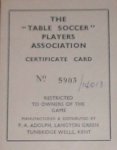
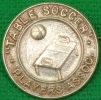
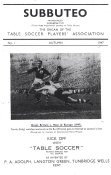
| Peter Upton's |
Subbuteo Tribute Website. |
|
The History of Competitive Table Soccer |
Introduction.
One of the things this site had lacked was a look at the serious side of playing Subbuteo. The reason for this was mainly one of experience on my part. When I was a kid, lots of toy companies ran clubs for fans of their products, and I joined these avidly. A chance of a members card, a badge, and maybe some exclusive tat, encouraged me to join clubs run by Airfix, Matchbox, Corgi and Lego. I was even a member of the Jaffa Cake Club. However, the Subbuteo club of the time remained reluctantly un-joined. Why? Simply because it was sold as a playing club, not a collecting club, and I guess I was intimidated. I was (and still am) a poor Subbuteo player, and to be frank, a stay-at-home geek. To paraphrase the adverts of the day, I did not want to test my skills against other players. So leagues and tournaments; clubs and societies; and the sheer scale of organised table soccer in the 1970s and 1980s happily passed me by. Or at least it did until I started this website, met fellow enthusiasts, and discovered some history.
Table Soccer, not Subbuteo.
For many who have rediscovered the joy of playing Subbuteo in the 21st century, the first puzzling thing to overcome is why the game is played under an unsatisfactory generic term, rather than the famous one. Oh, and don't even think of describing your hobby as "table soccer" to non-players, as images of bar-football will inevitably be conjured up. The main reason behind playing "not-Subbuteo" dates back to 1977, when there was a falling out between the committee of the English Table Soccer Association (ETSA) and Subbuteo Sports Games Ltd (SSG). (Believe me, by the end of this history, you'll have absorbed more than enough acronyms).
When I first started this website, I received lots of encouragement from nostalgic Subbuteo fans, and it is they who are responsible for the huge amount of detail on this site. I received criticisms, and suggestions for improvement (of course), but I only received one proper "flame" e-mail. The anger in this e-mail caught me by surprise, but when I'd calmed down and re-read it, the fury was obviously aimed at the game I was celebrating, i.e. Subbuteo, or at least the company who produced it. It showed that although, in some respects, this site is the ancient history of a game long past its peak, emotions could still be raw if provoked. This reason, coupled with my own inexperience, stopped me writing about the various table soccer associations on the site. However, this lack of detail has nagged away at me. The history of Subbuteo is incomplete without them, and the influences of the older players and federations is still felt today, not just in the lack of Subbuteo name, but in the general acceptance of different playing equipment, which has been key to the game's rejuvenation in these post-Waddingtons/SSG times. In addition, it could be argued that the rediscovery and appreciation of Newfooty was partly down to the anti-SSG feelings in the 1980s.
I have recently been lucky enough to have loaned to me the newsletters of the ETSA for the eventful period around the split with SSG. As I read through these honest and amusing accounts of playing table soccer (on a large scale), I felt inspired to return to the website, and to have a go at writing a playing history. So, treading a little carefully, here is a tribute to the organisers of Subbuteo, and Table Soccer down the ages.
Note:- I've deliberately avoided naming individuals, and I've tried to keep things simple. If any of the people involved want to clarify details, feel free to write in (but nicely please - flames I don't need).
The Table Soccer Players Association (TSPA) 1947-1964.



Subbuteo, like all good "family" games is simple to play, and difficult to master. Like chess, or Scrabble, there are those who will find some natural flair for the game, and will want to take it up as a serious pastime. Peter Adolph anticipated this by forming the first players association alongside the initial production of the game in March 1947. He called it The Table Soccer Players Association (TSPA). Indeed, in the accessory lists of the period, membership of the TSPA had a prominent place. Set A was the boxed game, and TSPA membership was Set B. It is perhaps significant that there is no mention of Subbuteo in the name of this original club. I assume this was simply because Peter Adolph launched the association before he had decided upon the Subbuteo name. However, this omission does achieve a later significance.
The first bulletin for members, called simply Subbuteo - The Organ of the TSPA, arrived in Autumn 1947. This A5 pamphlet had a full page editorial from Mr Adolph, which basically asked members to meet up, and play the game. He also apologied to those who had to wait for their badge, and further requested that members wear their badge "on every possible occasion". A further page of "news" invited members to the Schoolboys Own Exhibition at New Horticultural Hall, London in January 1948, announced the arrival of the Advanced Table Soccer booklet (became Set C), and advised that the new "super flattened bases" were now available in red, blue, black and white. These bases replaced the "button" bases that Subbuteo had originally launched with. The booklet finished with a list of names and addresses for all the members who had joined between March 1st 1947 and May 31st 1947. It is an impressive list, totalling five pages, and 400 members.
Issue two (Winter) of the bulletin, had details of members joining between June 1st and October 25th 1947. This was another 928 people. Amusingly, there seems to be a single girl among them. Hats off then, to Miss J Fay (aged 15) who lived in Cardiff. Peter Adolph's plan for the association was for members to run their own "Sectional Leagues". Each league was supposed to be limited to six players, and they would play each other four times each. The scores were sent to the Association, and a league table produced amalgamating these results. At this early stage, there were only seven sectional leagues although one, impressively, was in Gibraltar. The player with the best performance would be crowned World Champion, and be awarded the Silver Cup. It was a fine idea, but under estimated the sheer number of players joining the Association. With leagues limited to six players, and already 1300+ players, their was the potential to produce a lot of leagues, and a lot of champions with similar records.
By 1948 the bulletin had became an annual record, containing the results of the previous year, the sectional leagues, and the addresses of league secretaries. A further journal, "Table Soccer News" is mentioned in the 1950s, issued periodically to league secretaries. Peter Adolph seems to take a back seat with regards to the association in the 1950s, with the business, rather obviously, being his chief concern. Adolph's right-hand man, George Underwood was secretary, and leagues were asked to submit their results for entry into the annual bulletin. The association's committee then chose the most impressive players (as judged by their league standings) to play off for "The Silver Cup".
The Silver Cup competition was played during the annual Schoolboy's Own exhibition throughout the 1950s, and into the 1960s. This exhibition lasted a full week, with the Silver Cup played on the first weekend, and an "Exhibition Open Cup" played on the final weekend. This second tournament started in 1949, and seems to have been by invitation only. It was actually won twice by Peter Adolph himself (1952, 1954), and also by George Underwood (1956, 1957). The early 1950s Silver Cup competitions featured twelve players, and this was increased to sixteen in 1957.
The early versions of the Subbuteo bulletin also mention the hope of playing regular international matches between the Champion of England (Silver Cup Winner), and the champion of Belgium. I don't have any record of these matches sadly, although Underwood does describe one TSL player as J Woolcock of Ashdown (TSL) and England, suggesting that he had played in the international event (he won the Silver Cup in 1954-55).
Membership reference numbers:- Each member was given a reference containing two numbers. The card pictured at the top of this section shows the general format, with a printed number followed by a hand-written one. Both the figures were usually four digits, although this was not always the case. Looking at the lists in the first two bulletins, it is not obvious how these numbers were worked out. The first list is in alphabetical order, whilst the second is arranged by geographical location, but the reference numbers are a jumble in both. It seems that the printed numbers started at 1000. On the original list, The earliest number seems to be 1004, and the last 1398. In the second list, the numbers increase to the 1900s, but there are still a large number in the 1000-1400 range. The numbers are not unique, (if there were 1300 players, they can't all have a unique number between 1000 and 2000). In the second edition are players with the references 1001-1 and 1002-4, and there was also a 1002-2663. Peter Adolph lists himself as founder, sadly without a reference number. There were also five honorary members in the second booklet (also with no references). Unsurprisingly, four of these were from the Tunbridge Wells area.
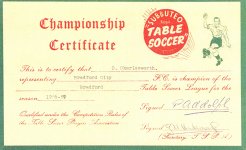
A Club in Review - The Bradford TSL.
As the bulletin was a simple list of league tables and cup finals, it is not easy to paint a picture of the TPSA. How much help did they give, and how pro-active was this organisation? The best details I have come from the Bradford Table Soccer League, whose record books, paperwork and trophies are owned by the ever helpful Ashley Hemming. The Bradford TSL seems to have had a relatively long history. forming in 1955-56 and playing until the mid-1960s. The papers suggest a league that grew from five in 1956-57, to eight in late 1950s, and to eleven or twelve in the early 1960s. As well as their own competitions, they also played inter-league matches with other clubs in the area, including Barnsley (where multiple Silver Cup Winner Brian Nixon reigned supreme), and Deansgate in Manchester.
There are glimpses of the support that the TPSA provided. Championship Certificates were awarded to league winners (1956-57 is shown), and George Underwood corresponded with the league secretary using lovely Subbuteo Sports Games headed note paper, asking about league tables, and providing information about the Silver Cup. In 1960, Mr Underwood also awarded the league an "Efficiency Cup", which "may be used for any competition which your committee may decide". That seems pretty generous. Two of Bradford's players were selected to play in the Silver Cup in 1960, held as usual in London in January. Mr Underwood advised that two thirds of fare expenses would be refunded on arrival.
The TSPA continued into the early 1960s. However, the growth of the game in Europe, and the introduction of the "Continental" OO scale equipment brought changes.
The European Table-Soccer Federation (ETF)
(1963- ).
The British Table Soccer Association (1965-67)
The English Table Soccer Association (1967- )
For Peter Adolph, and Subbuteo Sports Games Limited, the introduction of the OO scale figures in late 1961 really kick-started the amazing success story of Subbuteo. It was the stacks of magical green boxes in sports shops that attracted so many children to the game. The hand-painted, beautifully detailed figures and realistic accessories struck a cord with generations of small boys. However, for the older customers, those playing as a serious pastime, the new figures were a problem. However great they looked, they simply did not play the game as accurately as the old flat figures. The curl and spin was much harder to pull off (and the uneven shape of the figures could produce random results). The bigger, heavier bases also affected touch, and chipping was more difficult. So serious players stuck to the older figures.
Peter Adolph was never one to turn down a sale, so whilst he was in control of Subbuteo the flat celluloid and card figures remained part of the range. Indeed, both these types of figure received copies of all the new kits Subbuteo produced right through the 1960s. The problems came in the 1970s, when Waddingtons began to phase out this under-performing line. However, let's not get ahead of the story.
For the serious enthusiast, the key arrival of the early 1960s was not the OO scale figure, but the formation of the independent European Table Soccer Federation (ETF), based in Holland. Perhaps the most surprising thing about the ETF's formation date is the fact that Subbuteo was not even being actively marketed abroad at this time. Peter Adolph had done some promotional activity in Belgium, but that was about it. Perhaps that is why the OO scale figures did not make such a big impression on the European game at this time. However, there were European leagues in the TSPA in the 1950s. The 1957-58 bulletin had details of a large "Bavaria TSL", with eight players in their top flight, and a further three divisions below that.
The ETF organised a yearly competition called the Europa Cup, where the top two players from each member country played off against each other. First played in 1964, this competition quickly became the ultimate test for table soccer players. Typically, the country of Subbuteo's birth did not feature heavily in the prize giving at the Europa Cup. From 1964 to 1975, the competition was won by four different Dutch players (seven wins), two Belgians (three wins), and two Germans (a win each). No British player had even reached the semi-finals until 1975, but that year England had the runner-up, and the next year was an all-English final. It was all downhill after that though. In addition to the countries already mentioned, by the 1970s there was also players from Austria, Italy, Malta, Scotland and Switzerland challenging for the trophy. It is perhaps worth noting at this stage that the ETF allowed all types of playing equipment to be used, and that the Italians generally stuck to the OO scale figures, as supplied by their distributor Edilio Parodi. This meant that their early appearances saw them making up the numbers, but this was to change.
With the ETF established, an affiliated British association seemed to be a logical step. The first attempt was the British Table Soccer Association, which held championships in 1965-66 and 1966-67. The association then split, and new associations formed for the separate countries within the UK and Ireland. Essentially taking over from the BTSA, the English Table Soccer Association (ETSA) held an English Championship in 1967-68 and 1968-69, and then from the 1969-70 season hosted both a National League (of at least three divisions), and an English Challenge Cup, for which regional qualifiers were held. In addition, there were regional championships (the South-East was usually the biggest, with 50+ entries), regional and county leagues, inter-county matches, and many smaller leagues and one-off events. The ETSA also staged international matches, and the format was usually four players from each country playing against each other. The most frequent match-up was with the Welsh Table Soccer Assn (WTSN), although frequent dark mutterings about the dreaded "Welsh rules" abounded.
Through the 1960s and into the early 1970s, SSG seemed quite content to let the ETSA take over the running of the game. Perhaps they were pleased to be able to pass the workload to these enthusiastic volunteers. The final catalogue to offer TSPA membership was 1965-66, and for the rest of the 1960s there was instead, an offer to "test your skills with the British Table Soccer Association". In 1970-71 and 1971-72, the ETSA was mentioned, and you could even order the ETSA yearbook through SSG. Subbuteo's "Advanced rule book" had traditionally been Peter Adolph's attempt at a more mature form of Subbuteo, so this leaflet was another obvious place for the associations to be advertised. However, this did struggled to keep up with the changes. The 1967-68 rule book still mentioned the TSPA c/o Subbuteo. The following year had exactly the same blurb, but there was now a BTSA address in Romford. The first full page ETSA advertisement appeared inside the front cover of the re-written 1969-70 booklet. Explaining that the ETSA was formed "three years ago", this advert offered membership, and a monthly magazine, for 10/- a year. That monthly newsletter was called "The Blue", and I'll be looking at that in detail on the second page of this history.
The National Table Football League.
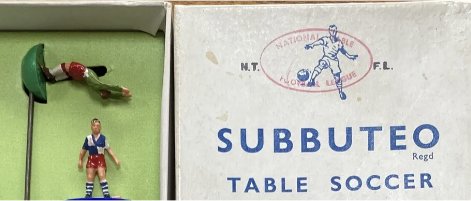
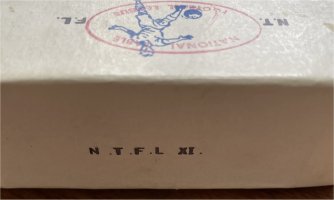
Here is an interesting puzzle. The pictures of this box were sent in by David Royle, and show a very early white box old heavyweight side (produced circa 1962). A rare box in lovely condition, with a partly repainted Bristol Rovers side. A great find for a collector, but it is on this page because of the very professional "National Table Football League" stamps. The team is early in date for a National League, and my understanding was that most of the league players of this period preferred to use flats. So much more detail is required to fill in the history of this one. Can any of the older players shed light on this one?
However, change was on the horizon. Subbuteo Sports Games Limited were taken over by Waddingtons in the late 1960s, and they were keen to promote and expand the game, especially in Europe and overseas. European distributors were assigned, and Subbuteo collectors have become familiar with seeing German, Dutch, French and Italian paperwork and boxes from this era. As the 1966 World Cup had provided a real boost to Subbuteo sales, Waddingtons decided to stage a show-piece international tournament to ride the wave of publicity for the 1970 event.
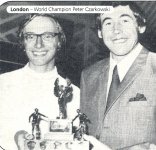
This large public event was staged on 22-23 August 1970 at the Savoy Hotel in London. It retrospectively became the first Subbuteo World Cup, but the report in the 1971-72 catalogue was not so grand, only calling it "Subbuteo's first international tournament". This moniker rather unfairly overlooked the successful Europa Cup, but the report did mention that Holland were the current European Champions, and that the whole thing was staged with the co-operation of the ETSA. Participation was limited to countries with organised table soccer associations, and thirteen two-player teams took part - Belgium, Eire, England, Gibraltar, Holland, Israel, Malta, N. Ireland, Scotland, Switzerland, USA, Wales, and West Germany. The 1971 catalogue only mentioned countries, not individuals, and reported that it was West Germany who won the John Waddington Trophy. Later catalogues gave the winner's name as Peter Czarkowski, and he later doubled-up by winning the Europa Cup in 1975.
The event was obviously seen as a huge success by Subbuteo, and so they began planning another next big event in time for the 1974 World Cup. This was the famous (at least among collectors!) Munich World Series, and I'll have a look at that too on the next page.
This page is has gone on for too long though, so I'll break the list at this point. If you are still waiting for the Subbuteo/table soccer split mentioned in the introduction - then you'd better keep going to the ETSA page.